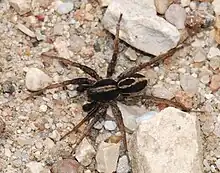| RTA clade Temporal range: | |
|---|---|
 | |
| Male Alopecosa albofasciata, a wolf spider and member of the RTA clade | |
| Scientific classification | |
| Domain: | Eukaryota |
| Kingdom: | Animalia |
| Phylum: | Arthropoda |
| Subphylum: | Chelicerata |
| Class: | Arachnida |
| Order: | Araneae |
| Infraorder: | Araneomorphae |
| Clade: | Entelegynae |
| Clade: | RTA clade |
| Clades | |
|
Dionycha and see text | |
The RTA clade is a clade of araneomorph spiders, united by the possession of a retrolateral tibial apophysis – a backward-facing projection on the tibia of the male pedipalp.[1] The clade contains over 21,000 species, almost half the current total of about 46,000 known species of spider.[2] Most of the members of the clade are wanderers and do not build webs.[3] Despite making up approximately half of all modern spider diversity, there are no unambiguous records of the group from the Mesozoic and molecular clock evidence suggests that the group began to diversify during the Late Cretaceous.[4]
Families
In 2005, Coddington included 39 families in a cladogram showing the RTA clade:[5]
- Agelenidae
- Amaurobiidae
- Ammoxenidae
- Amphinectidae (paraphyletic; merged into Desidae)
- Anyphaenidae
- Cithaeronidae
- Clubionidae
- Corinnidae
- Cryptothelidae
- Ctenidae
- Desidae
- Dictynidae
- Gallieniellidae
- Gnaphosidae
- Lamponidae
- Liocranidae
- Lycosidae
- Miturgidae (paraphyletic)
- Oxyopidae
- Philodromidae
- Phyxelididae
- Pisauridae
- Psechridae
- Salticidae
- Selenopidae
- Senoculidae
- Sparassidae
- Stiphidiidae
- Tengellidae (now merged into Zoropsidae)
- Thomisidae
- Titanoecidae
- Trechaleidae
- Trochanteriidae
- Zodariidae
- Zoridae (now a synonym of Miturgidae)
- Zorocratidae (no longer accepted; most genera now placed in Udubidae)
- Zoropsidae
References
- ↑ Coddington, Jonathan A. & Levi, Herbert W. (1991), "Systematics and evolution of spiders (Araneae)", Annual Review of Ecology and Systematics, 22: 565–592, doi:10.1146/annurev.es.22.110191.003025, JSTOR 2097274
- ↑ "Currently valid spider genera and species", World Spider Catalog, Natural History Museum Bern, retrieved 2015-10-14
- ↑ Hormiga, Gustavo & Griswold, Charles E. (2014), "Systematics, Phylogeny, and Evolution of Orb-Weaving Spiders", Annual Review of Entomology, 59 (1): 487–512, doi:10.1146/annurev-ento-011613-162046, PMID 24160416
- ↑ Magalhaes, Ivan L. F.; Azevedo, Guilherme H. F.; Michalik, Peter; Ramírez, Martín J. (February 2020). "The fossil record of spiders revisited: implications for calibrating trees and evidence for a major faunal turnover since the Mesozoic". Biological Reviews. 95 (1): 184–217. doi:10.1111/brv.12559. ISSN 1464-7931. PMID 31713947. S2CID 207937170.
- ↑ Coddington, Jonathan A. (2005), "Phylogeny and classification of spiders" (PDF), in Ubick, D.; Paquin, P.; Cushing, P.E. & Roth, V. (eds.), Spiders of North America: an identification manual, American Arachnological Society, pp. 18–24, retrieved 2015-09-24
This article is issued from Wikipedia. The text is licensed under Creative Commons - Attribution - Sharealike. Additional terms may apply for the media files.